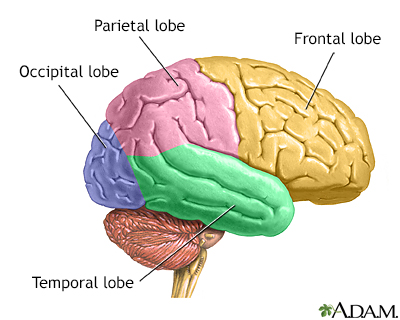Pregnancy SmartSiteTM
Nuclear magnetic resonance - cranial; Magnetic resonance imaging - cranial; MRI of the head; MRI - cranial; NMR - cranial; Cranial MRI; Brain MRI; MRI - brain; MRI - head DefinitionA head MRI (magnetic resonance imaging) is an imaging test that uses powerful magnets and radio waves to create pictures of the brain and surrounding tissues. It does not use radiation. How the Test is PerformedHead MRI is done in the hospital or a radiology center. You lie on a narrow table, which slides into a large tunnel-shaped scanner. Some MRI exams require a special dye, called contrast material. The dye is usually given during the test through a vein (IV) in your hand or forearm. The dye helps the radiologist see certain areas more clearly. During the MRI, the person who operates the machine watches you from another room. The test most often lasts 30 to 60 minutes, but may take longer. How to Prepare for the TestYou may be asked not to eat or drink anything for 4 to 6 hours before the scan. Tell your health care provider if you are afraid of close spaces (have claustrophobia). You may receive medicine to help you feel sleepy and less anxious. Or your provider may suggest an "open" MRI, in which the machine is not as close to the body. You may be asked to wear a hospital gown or clothing without metal ties (such as sweatpants and a t-shirt). Certain types of metal can cause blurry images. Before the test, tell your provider if you have:
The MRI contains strong magnets. Metal objects are not allowed into the room with the MRI scanner. This includes:
How the Test will FeelIf you need dye, you will feel the needle pinch in your arm when the dye is injected into the vein. An MRI exam causes no pain. If you have difficulty lying still or are very nervous, you may be given a medicine to relax. Too much movement can blur the images and cause errors. The table may be hard or cold, but you can ask for a blanket or pillow. The machine makes loud thumping and humming noises when turned on. You can ask for ear plugs to help reduce the noise. An intercom in the room allows you to speak to someone at any time. Some MRIs have televisions and special headphones that can help you pass the time or block the scanner noise. There is no recovery time, unless you were given a medicine to relax. After an MRI scan, you can go back to your normal diet, activity, and medicines. Why the Test is PerformedAn MRI provides detailed pictures of the brain and nerve tissues. A brain MRI can be used to diagnose and monitor many diseases and disorders that affect the brain, including:
An MRI scan of the head can also determine the cause of:
A special type of MRI called magnetic resonance angiography (MRA) may be done to look at blood vessels in the brain. What Abnormal Results MeanAbnormal results may be due to:
RisksMRI uses no radiation. To date, no side effects from the magnetic fields and radio waves have been reported. The most common type of contrast (dye) used is gadolinium. It is very safe. Allergic reactions to this substance rarely occur. However, gadolinium can be harmful to people with kidney problems who are on dialysis. If you have kidney problems, tell your provider before the test. The strong magnetic fields created during an MRI can make heart pacemakers and other implants not work as well. It can also cause a piece of metal inside your body to move or shift. ConsiderationsMRI is safe during pregnancy. In many cases MRI may be more sensitive than CT scan to problems in the brain such as small masses. CT is usually better at looking for small areas of bleeding. Tests that may be done instead of an MRI of the head include:
A CT scan may be preferred in the following cases, since it is faster and usually available right in the emergency room:
ReferencesBarras CD, Bhattacharya JJ. Current status of imaging of the brain and anatomical features. In: Adam A, Dixon AK, Gillard JH, Schaefer-Prokop CM, eds. Grainger & Allison's Diagnostic Radiology. 7th ed. Philadelphia, PA: Elsevier; 2021:chap 53. Chernecky CC, Berger BJ. Magnetic resonance imaging (MRI) - diagnostic. In: Chernecky CC, Berger BJ, eds. Laboratory Tests and Diagnostic Procedures. 6th ed. St Louis, MO: Elsevier Saunders; 2013:754-757. Khan M, Schulte J, Zinreich SJ, Aygun N. Overview of diagnostic imaging of the head and neck. In: Flint PW, Francis HW, Haughey BH, et al, eds. Cummings Otolaryngology: Head and Neck Surgery. 7th ed. Philadelphia, PA: Elsevier; 2021:chap 8. | |
| |
Review Date: 7/5/2022 Reviewed By: Jason Levy, MD, FSIR, Northside Radiology Associates, Atlanta, GA. Also reviewed by David C. Dugdale, MD, Medical Director, Brenda Conaway, Editorial Director, and the A.D.A.M. Editorial team. The information provided herein should not be used during any medical emergency or for the diagnosis or treatment of any medical condition. A licensed medical professional should be consulted for diagnosis and treatment of any and all medical conditions. Links to other sites are provided for information only -- they do not constitute endorsements of those other sites. No warranty of any kind, either expressed or implied, is made as to the accuracy, reliability, timeliness, or correctness of any translations made by a third-party service of the information provided herein into any other language. © 1997- A.D.A.M., a business unit of Ebix, Inc. Any duplication or distribution of the information contained herein is strictly prohibited. | |

 Brain
Brain Head MRI
Head MRI Lobes of the brain
Lobes of the brain
